INSTITUT SUPERIEUR D'ANTHROPOLOGIE
INSTITUTE OF ANTHROPOLOGY
ONLINE COURSES / COURS A DISTANCE
INSCRIPTION : Année Universitaire 2012/2013
REGISTRATION : Academic Year 2012 / 2013
AZERBAIDJAN –  Gabala - In the course of archaeological excavations in Gabala by the Institute of Archaeology & Ethnography of the National Academy of Sciences of Azerbaijan (AMEA) it was found a historical monument of Eneolithic period. Institute’s head Najaf Seidli says that the monument testifies of migration of Mesopotamia residents to the territory of the current South Caucasus. Later they continued to migrate in northern direction. "Our finding is beyond the scope of a local monument as there is already a fact of migration in different directions. This monument may interest scientists and tourists of countries on the territory where the historic Mesopotamia was situated,” he said. According to the expert, work on the site of finding of the archaeological monument of the medieval period will begin soon in Bilasuvar. "Every year more than 10 theses are protected the country, which are then presented at international thematic conferences. Currently, more than 100 out of 300 employees of the Institute are involved in the expeditions, each of which composes 4-5 people," Seidli said.
Gabala - In the course of archaeological excavations in Gabala by the Institute of Archaeology & Ethnography of the National Academy of Sciences of Azerbaijan (AMEA) it was found a historical monument of Eneolithic period. Institute’s head Najaf Seidli says that the monument testifies of migration of Mesopotamia residents to the territory of the current South Caucasus. Later they continued to migrate in northern direction. "Our finding is beyond the scope of a local monument as there is already a fact of migration in different directions. This monument may interest scientists and tourists of countries on the territory where the historic Mesopotamia was situated,” he said. According to the expert, work on the site of finding of the archaeological monument of the medieval period will begin soon in Bilasuvar. "Every year more than 10 theses are protected the country, which are then presented at international thematic conferences. Currently, more than 100 out of 300 employees of the Institute are involved in the expeditions, each of which composes 4-5 people," Seidli said.
http://abc.az/eng/news/main/67661.html
USA – 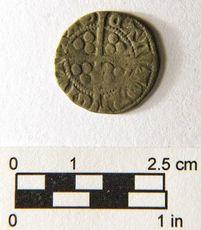 - Cape Neddick River - Linda Scotland was with her dogs at the Cape Neddick River in June 2011 when something caught her eye. "I always see broken shards of pottery along the river," she said. "That day, I was just sitting on a dinghy and staring at the sand when I saw something that looked like a bit of pottery." She picked it up and thought she had found a small religious medal. "I showed it to my neighbor, who's British," Scotland said. "She said it might be a coin." She dropped off the coin to Baker on Aug. 22, 2011, and Baker e-mailed images of the artifact to Barrie Cook, curator of medieval and early modern coinage at the British Museum in London. Cook responded that, while the "image is rather murky," the coin looks, from the shape of the crown, to be a penny of Edward I/II, circa 1305-1310, Canterbury mint. The coin was found on the shoreline amid the remains of a wharf that dates to at least the mid-19th century — and possibly back to 1649 — when the land was first granted to three Englishmen, he said. The land grant included the right to build a stage — or wharf — for their fishing operation. By the mid-17th century, there was a busy working waterfront, where it would have been easy for someone to drop a coin, Baker wrote in his report to the Museums of Old York. "Indeed, the site of the home of one of the three fishermen is only a couple hundred feet away," he wrote. The best alternative to someone dropping an old, but only moderately circulated, coin is the possibility the coin arrived with construction material for the wharf, through ship ballast. "Ships often gathered up piles of rock and sand in harbors and deposited them in their holds to make up weight for a light cargo," Baker said. "While it is an unusual find, such isolated early coin finds are not altogether unknown. Indeed, a Roman coin was found many years ago on the coast of Maine. It probably arrived here via ballast." The most famous historic coin found in Maine is a Norse silver penny from the 11th century, found in Blue Hill, Baker said. "This was the only European artifact found at the Native site, so would seem to suggest it was traded down the coast from the 11th-century Norse settlement at L'Anse aux Meadow, Newfoundland, via Native American trade routes," he said.
- Cape Neddick River - Linda Scotland was with her dogs at the Cape Neddick River in June 2011 when something caught her eye. "I always see broken shards of pottery along the river," she said. "That day, I was just sitting on a dinghy and staring at the sand when I saw something that looked like a bit of pottery." She picked it up and thought she had found a small religious medal. "I showed it to my neighbor, who's British," Scotland said. "She said it might be a coin." She dropped off the coin to Baker on Aug. 22, 2011, and Baker e-mailed images of the artifact to Barrie Cook, curator of medieval and early modern coinage at the British Museum in London. Cook responded that, while the "image is rather murky," the coin looks, from the shape of the crown, to be a penny of Edward I/II, circa 1305-1310, Canterbury mint. The coin was found on the shoreline amid the remains of a wharf that dates to at least the mid-19th century — and possibly back to 1649 — when the land was first granted to three Englishmen, he said. The land grant included the right to build a stage — or wharf — for their fishing operation. By the mid-17th century, there was a busy working waterfront, where it would have been easy for someone to drop a coin, Baker wrote in his report to the Museums of Old York. "Indeed, the site of the home of one of the three fishermen is only a couple hundred feet away," he wrote. The best alternative to someone dropping an old, but only moderately circulated, coin is the possibility the coin arrived with construction material for the wharf, through ship ballast. "Ships often gathered up piles of rock and sand in harbors and deposited them in their holds to make up weight for a light cargo," Baker said. "While it is an unusual find, such isolated early coin finds are not altogether unknown. Indeed, a Roman coin was found many years ago on the coast of Maine. It probably arrived here via ballast." The most famous historic coin found in Maine is a Norse silver penny from the 11th century, found in Blue Hill, Baker said. "This was the only European artifact found at the Native site, so would seem to suggest it was traded down the coast from the 11th-century Norse settlement at L'Anse aux Meadow, Newfoundland, via Native American trade routes," he said.
http://www.seacoastonline.com/articles/20120829-NEWS-208290380
FRANCE – 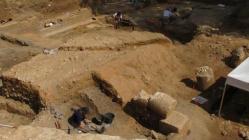
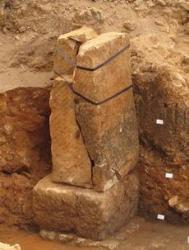 – Poitiers - Depuis le 6 août dernier, treize archéologues mettent au jour des traces de vie de nos lointains ancêtres, dans le chantier de fouilles, rue du Puygarreau. Une voie du Haut-Empire (milieu du IIe et IIIe siècle) d'une largeur de 7,50 m a été mise au jour. Elle est bordée de colonnades supportant probablement des portiques qui couvraient des trottoirs de 3,50 m de large. Ceux-ci longent de longs murs de façade. L'un d'eux borde un péristyle d'une riche demeure ouvrant sur un jardin. La fontaine (nymphée) découverte en juin devait le décorer. Une voie du Bas Empire (extrême fin du IIIe siècle/début du 4e siècle) est aménagée au-dessus de la précédente voie. Large de 4 m, elle porte les traces de nombreux passages de chariots. Elle aurait été utilisée pour la construction de l'enceinte de la ville. L'existence d'un talus en appui contre l'enceinte du Bas Empire est confirmée. Il n'y a pas trace d'habitat le long de l'enceinte jusqu'au Moyen Age. Une cave médiévale est en cours de dégagement. Les fouilles se poursuivront jusqu'au 12 octobre. Les archéologues s'attacheront à rechercher des traces éventuelles d'un village gaulois.
– Poitiers - Depuis le 6 août dernier, treize archéologues mettent au jour des traces de vie de nos lointains ancêtres, dans le chantier de fouilles, rue du Puygarreau. Une voie du Haut-Empire (milieu du IIe et IIIe siècle) d'une largeur de 7,50 m a été mise au jour. Elle est bordée de colonnades supportant probablement des portiques qui couvraient des trottoirs de 3,50 m de large. Ceux-ci longent de longs murs de façade. L'un d'eux borde un péristyle d'une riche demeure ouvrant sur un jardin. La fontaine (nymphée) découverte en juin devait le décorer. Une voie du Bas Empire (extrême fin du IIIe siècle/début du 4e siècle) est aménagée au-dessus de la précédente voie. Large de 4 m, elle porte les traces de nombreux passages de chariots. Elle aurait été utilisée pour la construction de l'enceinte de la ville. L'existence d'un talus en appui contre l'enceinte du Bas Empire est confirmée. Il n'y a pas trace d'habitat le long de l'enceinte jusqu'au Moyen Age. Une cave médiévale est en cours de dégagement. Les fouilles se poursuivront jusqu'au 12 octobre. Les archéologues s'attacheront à rechercher des traces éventuelles d'un village gaulois.
http://www.lanouvellerepublique.fr/Vienne/Loisirs/Patrimoine-tourisme/n/Contenus/Articles/2012/08/30/Fouilles-de-Puygarreau-deux-voies-decouvertes
FRANCE – 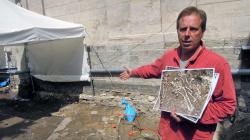 Boulogne sur Mer - Qui sont les personnes enterrées sous la cathédrale de Boulogne ? A quoi servait le bâtiment public dont les fondations ont été mises au jour par les archéologues ? Eh bien, ce sont à ces questions, et à d'autres, que vont tenter de répondre les chercheurs de l'INRAP à partir de septembre. Les découvertes réalisées dans la crypte de Boulogne vont être analysées. Les conclusions historiques et scientifiques de cette analyse, qui peut durer 2 ou 3 ans, seront ensuite publiées dans un livre.
Boulogne sur Mer - Qui sont les personnes enterrées sous la cathédrale de Boulogne ? A quoi servait le bâtiment public dont les fondations ont été mises au jour par les archéologues ? Eh bien, ce sont à ces questions, et à d'autres, que vont tenter de répondre les chercheurs de l'INRAP à partir de septembre. Les découvertes réalisées dans la crypte de Boulogne vont être analysées. Les conclusions historiques et scientifiques de cette analyse, qui peut durer 2 ou 3 ans, seront ensuite publiées dans un livre.
Reportage = http://www.deltafm.fr/actu/actu-22670.html
ROYAUME UNI – Ilkley - Possible medieval remains have temporarily halted redevelopment of an Ilkley church. All Saints Parish Church, Church Street, Ilkley, based on the site of Ilkley’s Roman fort, is awaiting Government permission for an archaeology dig. English Heritage said there could be medieval and post-medieval remains of “high significance” on the site, as well as buried Roman, post-Roman and Saxon archaeology. The dig will include two shallow trenches to a depth of half a metre on the site earmarked for the link building. The length of time taken for the actual dig will be dictated by what if any archaeological remains are found. All Saints submitted a planning application for its link building to Bradford Council early this year. The plan has yet to be determined. The development is situated within the remains of Olicana Roman Fort, say archaeologists, which is thought to have been built by Agricola in AD70 to 80. Excavations of the site last century concentrated on the northern section of the fort, but it is believed the ancient headquarters, or “principia”, is in the south of the site, in the church.
http://www.thetelegraphandargus.co.uk/news/local/localbrad/9902797.Medieval_probe_halts_work_at_Ilkley_church/
ROYAUME UNI - Polesworth Abbey - Items found during an eight-week archaeological dig at the north Warwickshire site were put on show, while there were also demonstrations of tile making and stone masonry and a talk about what life was like for a Benedictine nun. The abbey was founded in the ninth century and is a scheduled ancient monument, although apart from the church and the gatehouse and the restored ruins of the cloister, very little remains visible. During the dig volunteers, supported by a professional team from Northamptonshire Archaeology, have revealed parts of buildings not seen for hundreds of years, as well as artefacts such as coins, fragments of glass, roof tiles, pottery and valuable decorated floor tiles.
http://www.coventrytelegraph.net/news/north-warwickshire-news/2012/08/31/medieval-finds-on-show-at-north-warwickshire-abbey-92746-31732301/
BULGARIE - St Kirik island - An ancient incense vessel in the shape of a bull’s head, estimated to date from the sixth century BCE, has been found by archaeologists on St Kirik island off the Bulgarian Black Sea town of Sozopol. The discovery was made on the last hour of the last day of the 2012 summer archaeological season. Public broadcaster Bulgarian National Television quoted John Stevenson, a Harvard student volunteer working on the dig, as saying that the find was a great surprise and one of the most interesting made this season. Archaeologist Dragomir Garbov said that the vessel probably was used by the earliest settlers in Apollonia Pontica, an ancient name for Sozopol. The head of archaeological excavations, Kristina Panayotova, said that the find was “very rare”, the only such incense vessel in the shape of a bull’s head that had been found in Bulgaria. “This really is the crown of our work on St. Kirik even just for this season,” Panayotova said.
http://sofiaglobe.com/2012/08/31/archaeology-incense-vessel-in-shape-of-bulls-head-found-on-island-off-bulgarias-sozopol/
FRANCE – Saint-Lys - Au lieu-dit Les Graouats, à la sortie de Saint-Lys en direction de Fontenilles, des sondages archéologiques viennent d'être menés par l'INRAP. Éric Tranier explique : «sur cette tranche numéro 2 de la future déviation, nous avons trouvé un fossé qui nous fait penser à un enclos, peut-être d'époque médiévale. Nous avons également mis au jour des galets aménagés, dont un biface datant du paléolithique ancien (-100 000 ans environ). Ces galets seront étudiés par Marc Jarry, confrère spécialiste du paléolithique au laboratoire de l'INRAP à Saint-Orens. On retrouve aussi l'empreinte des traces de plantations de vigne ou de souches d'arbres, ce qui ne nous étonne pas car la forêt de la Bouconne s'étendait auparavant jusqu'aux portes de la bastide saint-lysienne. Ces sondages nous permettent de mieux étudier le paysage ancien et de faire des études comparatives». La toponymie éclaire aussi beaucoup sur le passé. Ainsi, selon M. Tranier, «il y avait peut-être un pressoir à huile au lieu dit Aulières (olière au XVIIe siècle). Le nom de la Pescadoure, autre lieu-dit de la commune, pourrait provenir d'une pêcherie implantée non loin de la Grange d'Ayguebelle».
http://www.ladepeche.fr/article/2012/08/31/1428950-saint-lys-deviation-sondages-archeologiques-avant-travaux.html
FRANCE - 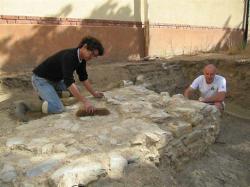 Rennes - Depuis lundi, deux archéologues sont à pied d'oeuvre sur le site de la caserne Saint-Georges. Dès les premiers sondages, ils n'ont pas été surpris de découvrir les vestiges d'une abbaye datant du XIe siècle. Des recherches, menées en 2007 par l'historien du patrimoine Gérard Danet et l'architecte Yves Lecoq, en détaillaient les plans. « Le duc Alain III a souhaité fonder l'abbaye en 1032 pour sa soeur Adèle, l'une des premières bénédictines de Saint-Georges »,raconte Gérard Danet. Constitué d'une abbatiale, d'un cloître, d'une cuisine, d'un réfectoire ou encore d'une hôtellerie, le bâtiment se trouve alors en dehors des fortifications. Ce n'est qu'au XVe siècle que deux enceintes successives l'incluent dans la ville. Au milieu du XVIIe siècle s'ajoute le palais Saint-Georges, ou « logis ». Il est le seul bâtiment encore existant. De la Révolution aux années 1810, le lieu a en effet été confié aux militaires, qui ont démoli l'abbaye. « Mais ils en ont dressé tous les plans, conservés au service historique de la Défense, à Vincennes », souligne Gérard Danet. On y découvre que le cloître se trouvait à l'endroit du parking de la caserne. L'entrée de l'abbaye correspondait au portail actuel. L'abbatiale occupait la place de la piscine, construite entre 1923 et 1925. Les vestiges « ne sont pas aussi bien conservés qu'on l'espérait »,regrette Dominique Pouille. Mais la terre sait récompenser ses chercheurs.« Nous venons de trouver les vestiges d'un bâtiment gallo-romain, c'est une vraie surprise ! C'est la trace antique la plus orientale trouvée à Rennes. »
Rennes - Depuis lundi, deux archéologues sont à pied d'oeuvre sur le site de la caserne Saint-Georges. Dès les premiers sondages, ils n'ont pas été surpris de découvrir les vestiges d'une abbaye datant du XIe siècle. Des recherches, menées en 2007 par l'historien du patrimoine Gérard Danet et l'architecte Yves Lecoq, en détaillaient les plans. « Le duc Alain III a souhaité fonder l'abbaye en 1032 pour sa soeur Adèle, l'une des premières bénédictines de Saint-Georges »,raconte Gérard Danet. Constitué d'une abbatiale, d'un cloître, d'une cuisine, d'un réfectoire ou encore d'une hôtellerie, le bâtiment se trouve alors en dehors des fortifications. Ce n'est qu'au XVe siècle que deux enceintes successives l'incluent dans la ville. Au milieu du XVIIe siècle s'ajoute le palais Saint-Georges, ou « logis ». Il est le seul bâtiment encore existant. De la Révolution aux années 1810, le lieu a en effet été confié aux militaires, qui ont démoli l'abbaye. « Mais ils en ont dressé tous les plans, conservés au service historique de la Défense, à Vincennes », souligne Gérard Danet. On y découvre que le cloître se trouvait à l'endroit du parking de la caserne. L'entrée de l'abbaye correspondait au portail actuel. L'abbatiale occupait la place de la piscine, construite entre 1923 et 1925. Les vestiges « ne sont pas aussi bien conservés qu'on l'espérait »,regrette Dominique Pouille. Mais la terre sait récompenser ses chercheurs.« Nous venons de trouver les vestiges d'un bâtiment gallo-romain, c'est une vraie surprise ! C'est la trace antique la plus orientale trouvée à Rennes. »
http://www.ouest-france.fr/actu/actuLocale_-Sous-la-caserne-Saint-Georges-une-abbaye...-_40887-2108442------35238-aud_actu.Htm
INDE – Dehli - The Archaeological Survey of India (ASI) Friday told the Delhi High Court that the Indian Institute of Technology (IIT) Kanpur would carry out a survey to ascertain if there any Mughal-era mosque structure existed near Subhash Park in central Delhi. The court handed over the site to the ASI to ascertain if the ruins were indeed the remains of the Akbarabadi mosque from the Mughal era.
http://www.newkerala.com/news/newsplus/worldnews-74076.html#.UED2stbN9wo